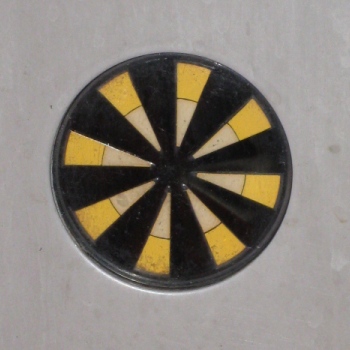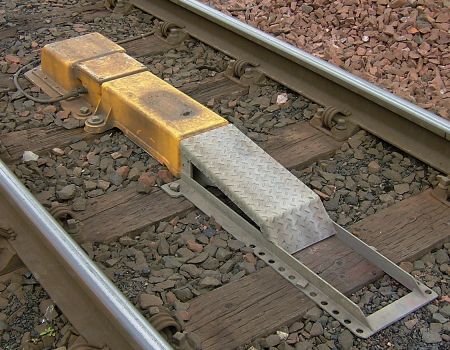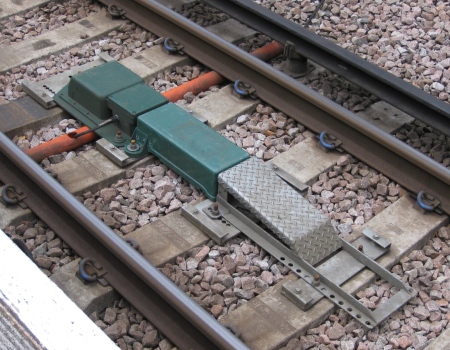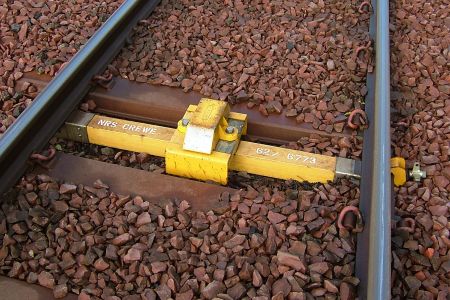|
|
|
The Automatic Warning System (AWS) is provided as a safeguard against a driver failing to respond to a signal or misreading its aspect. If a driver should fail to acknowledge an AWS warning within approximately two seconds, a full brake application is automatically initiated. Because this intervention occurs at the distant signal or 'caution' aspect and braking continues until the warning is acknowledged, the AWS can bring the train to a stand before it reaches the stop signal ahead.
The principal forerunner of today's Automatic Warning System was the Great Western Railway's "Automatic Train Control" (ATC) system, which it introduced in 1906. Originally known as "audible cab signalling", it rang a bell in the driver's cab if the distant signal was 'clear' or sounded a siren if it was at 'caution'. The driver could silence the bell or siren by lifting a resetting handle. The system's name was changed to ATC around 1910, when it was modified so that the warning siren was accompanied by an automatic brake application. The brakes were released when the driver lifted the resetting handle. Around 1916, a further modification was made so that the bell would only ring for a short duration, no longer needing an action from the driver to silence it.

|
| Fig. 1: AWS 'sunflower' indication. |
|---|
The GWR ATC system relied on physical contact between the train-borne equipment and a ramp mounted in the 'four-foot'. The ramp was electrically energised when the associated distant signal was 'off'. The system did not lend itself to use on single track railways, as complex arrangements were necessary to avoid unwanted indications being given to trains running in the opposite direction to which the ramp applied. Apart from a couple of early exceptions, single track railways were not fitted with ATC.
The ramp was normally situated 440 yards (402 metres) on the approach to the distant signal but was positioned immediately ahead of any signal that carried stop and distant arms on the same post. Placing the ramp beyond the signal meant that a train passing over it after having been detained at the stop signal would receive the appropriate indication according to whether the distant arm was 'on' or 'off'. The same principle was not followed in areas of continuous colour light signalling, where every running signal acted as a stop signal as well as a distant signal for the next signal ahead. If the ramps had been positioned ahead of the signals, the usefulness of ATC in alerting the driver of the approach to a signal during fog or falling snow would be lost. For colour light signals, the ramp was therefore positioned on approach to the signal but at a reduced distance of 200 yards (183 metres) to allow for signals being closely spaced.
In 1945, the GWR devised a modification to produce a distinctive audible indication for a double yellow aspect, comprising the sounding of an air horn together with the normal siren. The modified system was put on trial on the Henley branch in January 1946 and later between Reading and Maidenhead, and although it was successful, it was never used in normal service.
The Hudd (or "Strowger-Hudd") system had been developed in 1930. The track equipment comprised a permanent magnet followed by an electro-magnet about 50 feet (15 metres) ahead, both fixed centrally in the 'four-foot'. The absence of physical contact between the track equipment and the train made the system more suited to high-speed running than the GWR ATC system. The 'clear' indication was a short horn and the warning indication was a long horn. An additional feature of the Hudd system was a visual indicator inside the driver's cab. The first operational trials of the Hudd system were carried out on the Southern Railway at Wraysbury, and later at Byfleet. The LMS installed the system on the London, Tilbury & Southend line (where fog was a problem) in 1937, but widespread fitment elsewhere did not take place, due in part to the outbreak of war.
Following nationalisation in 1948, British Railways set about developing an improved ATC system to become the new standard for use across the whole network. The project was given added urgency by a terrible crash at Harrow & Wealdstone on 8 October 1952. The BR system incorporated the best features of the GWR and Hudd systems, i.e. the distinctive audible indications (bell and horn) of the former and the magnetic track equipment of the latter. After years of extensive testing and refinement, the British Railways standard system of Automatic Train Control was approved by the Ministry of Transport in November 1956. It was retitled as the "Automatic Warning System" (AWS) in 1959, and the ex-GWR ATC system was correspondingly redesignated as the "Western Region Automatic Warning System" (WR AWS).

|
| Fig. 2: AWS track equipment (standard strength). |
|---|
The audible indications of AWS are a bell for the 'clear' indication and a horn for the warning indication. The driver presses and releases an acknowledgement button to cancel the horn and the automatic brake application. AWS incorporated the visual indicator of the Hudd system, originally intended only for test purposes but ultimately retained as a standard feature. The indicator shows 'all black' when the train passes over the track equipment on the approach to a signal. If the signal is showing 'clear', the indicator remains 'all black'. If the signal is showing 'caution' or 'danger', then as soon as the acknowledgement button is pressed, the indicator changes to a visually striking pattern of black and yellow segments, referred to as the 'sunflower'. This indication is a reminder to the driver that the warning has been acknowledged and that he or she has full responsibility for controlling the train.
Like the Hudd system, AWS track equipment comprises a pair of magnets fixed centrally in the 'four-foot', but has the electro-magnet positioned immediately beyond the permanent magnet. The equipment was installed a nominal 200 yards (183 metres) on approach to the signal to which it applies. This standard distance applied irrespective of whether the signal was an isolated semaphore distant, a distant combined with a stop signal, or a colour light signal.
At first, and in common with the GWR ATC system, it was intended that AWS equipment would not be fitted on single line railways. This conveniently avoided the necessity to suppress the AWS equipment to prevent unwanted indications being given to trains running in the opposite direction to which the track equipment applied. Before the 1980s, bi-directional signalling had not been a common feature on Britain's railways, it being mainly confined to short distances within complex station areas. Suppressor inductors could be used in such situations. A suppressor inductor has a suppressing coil which, when energised, diverts the magnetic flux from the permanent magnet and so prevents an indication to the train. Wherever possible, bi-directional lines made use of 'common magnets' which apply to signals in both directions and never need to be suppressed. Some through stations where the track layout was complex and speeds were low (30 mph or less) were designated as "AWS gaps". No AWS equipment was provided inside those areas. Lineside signs were erected to mark the commencement and termination of the gap.
In areas of continuous colour light signalling (using three or four-aspect signals), every signal was fitted with AWS equipment. A 'clear' AWS indication was given only with a green aspect; any other aspect was accompanied by an AWS warning. It was not practice to provide AWS for colour light signals at the exits of loops, which would invariably be displaying a red aspect when approached.

|
| Fig. 3: AWS track equipment (extra strength). |
|---|
The Southern Region of British Railways was reluctant to introduce BR AWS and instead concentrated on the widespread provision of colour light signalling. Colour light signals were considered to be a safety enhancement in themselves on account of their superior visibility, which made them less prone to being disregarded. In addition, colour light signalling would enhance track capacity, whereas AWS alone would not. The Southern Region operated a busy network where trains regularly ran close together under double yellow aspects. This had led to concerns that the repetitive cancellation of AWS warnings could become an automatic reaction for drivers to the extent that they might fail to respond when confronted with a single yellow or red aspect. Furthermore, the presence of third rail electrification on the Southern Region made AWS fitment more difficult, although a solution to this was approved in 1964. The AWS receiver on third rail electric stock is mounted on the underside of the vehicle body rather than on the leading bogie. To allow for vertical movement resulting from vehicle suspension, the receiver is higher above the track and, for this reason, extra strength AWS track equipment is used in third rail areas. These magnets are painted Brunswick green to distinguish them from the standard strength magnets, which are painted yellow.
In the late 1960s, an enhanced form of AWS went on trial between Southampton and Bournemouth. Originally called "Southern Region AWS", its name was later changed to "Signal Repeating AWS". The SRAWS system repeated the next signal's aspect (and displayed a reminder of the previous signal's aspect) on an indication inside the cab. Any aspect other than green had to be acknowledged by the driver pressing the correct button that corresponded to the indication on display. If the driver did not acknowledge the indication, or the wrong button was pressed, an automatic brake application was initiated. The risk of error from subconscious cancellation was therefore greatly diminished.
Development of SRAWS ended in 1975 when the British Railways Board decreed that the Southern Region should equip its lines with the BR AWS system.
Following a derailment on the curve at Morpeth on 7 May 1969, the British Railways Board agreed to the provision of advance warning indicators on the approach to certain permanent speed restrictions (PSRs). These indicators began to appear from 1971. On lines fitted with AWS, a permanent magnet, which always causes a warning indication to be received by passing trains, was installed on the approach to each advance warning indicator.

|
| Fig. 4: A portable AWS magnet. |
|---|
On 6 June 1975, a high-speed derailment occurred at Nuneaton as a consequence of the lights in a gas-lit temporary speed restriction (TSR) warning board being extinguished. As a recommendation of the Department of Transport's report into the derailment, provision of AWS equipment was extended to include TSR warning boards. From September 1977, a portable temporary AWS magnet was to be installed on the approach to each warning board, to cause a warning indication to be given inside the cab of trains. A portable magnet will not be provided inside an AWS gap, however.
There is no facility to suppress a portable AWS magnet. On a single or bi-directional line, a warning indication will be received regardless of the train's direction of travel. Where this situation arises, a 'cancelling indicator' will be installed ahead of the magnet, in the opposite direction from the warning board. This sign advises the driver that the AWS warning just received does not apply to movements in that direction and must be cancelled in the usual way and then disregarded.
Once the decision had been made to fit AWS on single line railways, the expense and complication of providing suppressor magnets could be avoided on certain categories of line by simply advising drivers to disregard the non-applicable AWS warning they received when making opposite direction movements. Before long, permanently installed AWS cancelling indicators were being erected for such movements. Not providing suppression is particularly beneficial in cost terms where an AWS warning indication is invariably wanted (e.g. a fixed distant signal or PSR warning indicator), because it can potentially eliminate the need for power to be supplied to those locations.
Before TPWS became available, an early attempt at SPAD mitigation had entailed fitting an AWS suppressor magnet immediately beyond certain 'high risk' stop signals, in addition to the usual AWS equipment on approach. The additional magnet was suppressed when the signal displayed a 'proceed' aspect, but in the event of a SPAD, an AWS warning was given to the driver. The first such installation was at Hever in January 1990. The majority of signals so fitted were platform starting signals.
In May 1988, most of the signals on the Fast lines between Peterborough and Stoke Tunnel on the East Coast Main Line became capable of displaying a flashing green aspect in connection with high-speed trials up to 140 mph. A flashing green aspect gave the driver of a test train authority to exceed 125 mph. If the next signal was displaying a steady green aspect, speed had to be reduced to 125 mph. The AWS gave a 'clear' indication for either a steady green or a flashing green. This was not entirely satisfactory, because the driver of a train approaching a red aspect would receive the first AWS warning at the double yellow aspect although braking might need to have started at the steady green aspect.
In 2001, the nominal distance for positioning AWS equipment from the signal was slightly reduced, to 180 metres (197 yards). Where the permissible speed exceeded 100 mph however, the distance was increased to a nominal 230 metres (252 yards). AWS equipment was positioned at the increased distance on the West Coast Main Line, but the requirement to do so in future works was withdrawn in 2012.
|